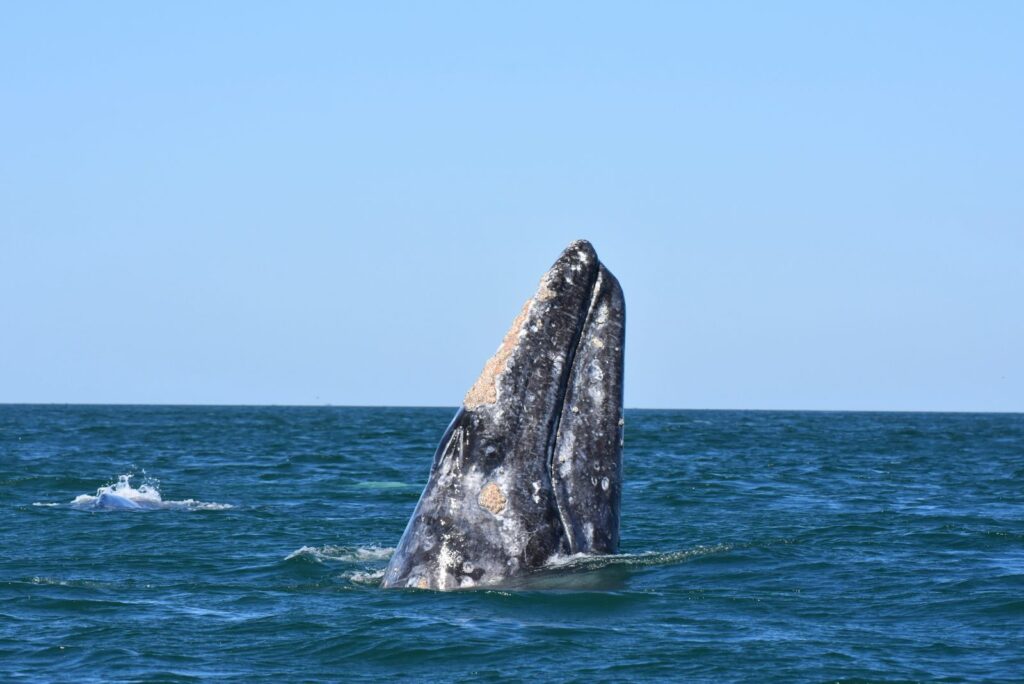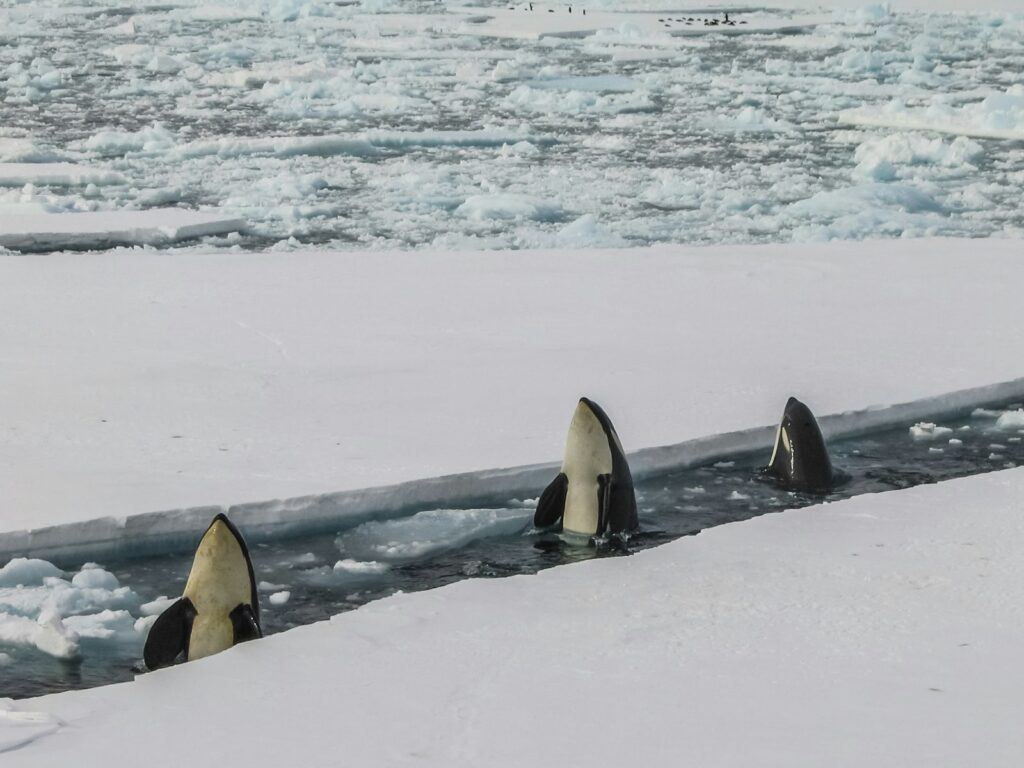Sperm whales sleep vertically, a curious behaviour unusual in other whale species.
What are the physiological mechanisms and the evolutionary pressures that might have shaped such behaviour? How do these giants manage oxygen consumption and buoyancy for such periods? What threats could be attracted by this vulnerable state?
Key Takeaways
- Sperm whales sleep vertically, suspended in water. They take short naps lasting 15-20 minutes.
- The vertical position facilitates easier breathing and minimises movement.
- Sperm whales have two forms of drift dives: “head-down” (greater depth, stability) and “head-up”.
- In Sperm whales, unihemispheric slow-wave sleep allows one brain hemisphere to rest while the other remains alert.
- Vertical sleep minimises muscular effort, reducing energy expenditure.
- Periodic surfacing for conscious breathing is necessary. The vertical position keeps the blowhole unobstructed for quick breaths.
- Groups of whales sleep vertically together, enhancing safety and social bonds.

Unique Sleeping Behavior
Sperm whales exhibit this curious sleeping behaviour of resting vertically in the water, a unique method among marine mammals. This posture, where the whales sleep suspended, allows them to take short, efficient naps lasting approximately 15 to 20 minutes each. During these moments, the whales appear almost motionless, with their bodies upright and heads slightly tilted downwards.
This behaviour was uncovered through studies using suction cup tags, recording whales’ activities and revealing that sperm whales worldwide conduct passive shallow “drift-dives” in a stereotypical vertical posture. This unique sleep behaviour has implications for understanding marine mammals‘ sleep patterns and adaptive strategies.
Vertical Sleep Mechanics
Sperm whales alternate resting time and vigilance. Assuming a vertical position just below the water’s surface helps them maximise their resting time while being ready to quickly responding to potential threats.
This unique posture may result from evolutionary adaptations linked to their deep-diving capabilities, allowing them to maximise alertness with minimal energy expenditure.
The vertical sleep mechanics involve minimal movement and rely heavily on the whale’s ability to regulate its buoyancy and remain partially submerged. This position may facilitate easier breathing during sleep, as they do not need to swim actively to breathe.
The mechanics of vertical sleep in sperm whales involve two distinct forms of drift dives: “head-down” and “head-up.” During head-down drift dives, whales can achieve greater depths compared to head-up drift dives, although the duration of these dives does not significantly differ. The deeper head-down posture may provide more stability for resting whales. Drift dives are rare, accounting for 7% of recorded time or 31.7% of non-foraging time, with bouts of drift dives ranging from short periods of less than a minute to longer intervals of over three hours.
Central to understanding these sleep mechanics is the role of the sperm whale’s brain. Unlike humans, whose sleep involves the simultaneous rest of the entire brain, the sperm whale’s brain may exhibit unihemispheric slow-wave sleep. This characteristic allows one half of the brain to rest while the other half remains alert, enabling the whale to surface for air and remain responsive to the environment.
Energy Conservation Strategies
How do sperm whales optimise energy conservation during their vertical sleep?
This intriguing behaviour is an adaptation and a strategy for energy conservation. By resting in a vertical position, sperm whales can maintain a state of minimal activity. This posture minimises the muscular effort needed to stabilise their bodies, reducing energy expenditure significantly.
The vertical sleep posture is closely tied to the functioning of the sperm whales’ brains. This sleeping position may help manage brain temperature and metabolic rate, aiding energy conservation. The vertical alignment in the water column ensures that the sperm whales can maximise their rest periods without completely shutting down their awareness of the surrounding environment.
Drift dives represent a low-activity state that likely serves as an energy conservation strategy for sperm whales. Unlike deep foraging dives, which involve steady swimming and the production of echolocation clicks, drift dives are characterised by inactivity and a passive vertical posture. This restful state may allow whales to engage in more efficient bi-hemispheric sleep. The ability to rest while drifting could help sperm whales conserve energy in the demanding ocean environment.

Breathing During Sleep
While the vertical sleep posture aids in energy conservation, it also necessitates periodic surfacing for breathing, a key aspect of the sperm whales’ slumber. As toothed whales, sperm whales are conscious breathers who must actively decide when to breathe, unlike terrestrial mammals that breathe reflexively. This need to rise to the surface to breathe is vital during their vertical sleep or ‘logging,’ where they remain motionless with their blowhole above the water’s surface.
The vertical position is strategic, enabling the whale to keep its blowhole unobstructed and ready for a quick breath. These short, approximately 10 to 15-minute bursts of sleep might seem brief, but they are effective enough for the sperm whales to rest while minimising vulnerability to threats and environmental hazards.
The ability to control their buoyancy plays a significant role in maintaining this delicate balance between sleep and the necessity for oxygen. By adjusting their buoyancy, sperm whales ensure they remain sufficiently afloat to breathe yet submerged enough to gain the benefits of sleep.
Social Reason for Sleeping Vertically
The vertical sleeping behaviour of sperm whales may also have social implications. Groups of vertically drifting whales have been observed to be unusually nonresponsive to approaching vessels, reacting only when touched. This suggests that they might be in a state of sleep during these drift dives. The social aspect of this behaviour is evident, as whales often engage in drift dives together, potentially providing safety in numbers and allowing them to maintain social bonds even while resting. The communal aspect of vertical sleeping may also aid in predator avoidance and enhance group cohesion.
Conclusions
The vertical sleep behaviour of sperm whales represents a unique adaptation to life’s challenges in the ocean. By drifting vertically below the surface, these animals can rest efficiently while maintaining essential functions such as breathing and social interaction.



